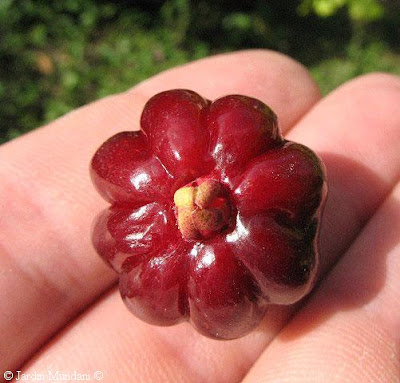Pitanga, Surinam Cherry, Cayenne Cherry, Brazil Cherry, Capuli, Guinday, Ñangapiré, Pedanga,… all these names and more receives this South American shrub of the Myrtaceae family. Their scientific names are also numerous: Eugenia uniflora, Eugenia microphylla, Myrtus brasiliana, Stenocalyx uniflorus and Plinia pedunculata. The Indians of Paraguay and northeast of Argentina call Ñanga-piri in their guarani language.
Ripe fruit of Eugenia uniflora in November. The leaves draw attention that with the cold of the autumn acquire an alive red blood color when synthesizing anthocyanins like mechanism of defense against the low temperatures. The Pitanga of the photo is a unit worked in a coastal town of Majorca Island located in the west of the Mediterranean basin, where the frosts are rare, smooth and of little duration.
Flowers of Pitanga in April. They have the typical structure of all Myrtaceae. Particularly striking is the faint red line running through the petals and the blood red color of the leaves.
Same flowers earlier view from another angle. Give off a sweet perfume which attracts pollinating bees.
Leaves of Surinam Pitanga in February, the coldest month of Majorca. The concentration of anthocyanin is maximum. With this so dark color the leaves are warmed up with solar rays and thus avoid the intense cold freeze. In especially cold winters with heavy frosts the Pitanga behaves as deciduous and loses all the leaves to survive. Temperatures below -3ºC kill the young units and below -5ºC damage the adult plants mortally.
In summer the leaves lacking anthocyanin and have a nice light green. The crushed leaves contain a resin that repels flies. The infusion of the leaves has diuretic, digestive and anti-diarrheal. The bark decoction as a gargle relieves throat illnesses.
In South America Eugenia uniflora is an evergreen tropical shrubs and flowers and fruits several times a year. Its natural habitat is the tropical jungles of the two Guyanas, Suriname, Argentina, Brazil and Paraguay. The Portuguese traders took to the Far East where it is now widely cultivated as an ornamental plant in India, Philippines, Samoa, Sri Lanka and China, but also eat fruit. In recent decades has been introduced as a garden plant in many other countries in the world with tropical, subtropical and temperate, thanks to its adaptability and its ability to behave as deciduous. In some countries there has been wild.
Surinam Cherry or Pitanga an intense dark red very bright. They draw attention to the eight ribs. The flesh is very juicy and sweet and has an exotic resinous taste, less pronounced when fully ripe. It is rich in vitamins and minerals, especially vitamin A, iron, calcium and phosphorus. Pitanga fresh juice is delicious. With the pulp is prepared jellies and jams.
Details of the eight ribs and persistent calyx. Inside each fruit is a spherical seed or two or three flattened seeds which are highly perishable and should be sown as soon as possible in a few days they lose their ability to germinate.
Eugenia uniflora prefers acidic soils rich in organic matter with a pH between 5.5 and 6.5, but tolerates slightly alkaline land than they are not karsts. Likes full sun to grow from sea level to 1700 meters. and reaches 7.5 meters.







very good practical (cultural)information based on observation, wel done !
ReplyDeleteBeautiful images! Great botanical illustrations!
ReplyDeleteHi Juan! What a beautiful plant! I tried to get some seeds via ebay, etc. but didn't work out...
ReplyDeleteDo you think I could get some fresh seeds from you?
(I can pay the postage of course!)
You would make me happy :), greetings from Germany
Hi Anonimous:
DeleteI do not have seeds. My Eugenia is very old and sick and has not given me any fruit this year. On this website there are seeds for sale at a good price:
http://www.sandemanseeds.com/search.asp
In search you write Eugenia.
Best regards.
Hello,
ReplyDeleteWhere do you sale eugenia uniflora dried leaves?
I don't know, sorry.
Delete